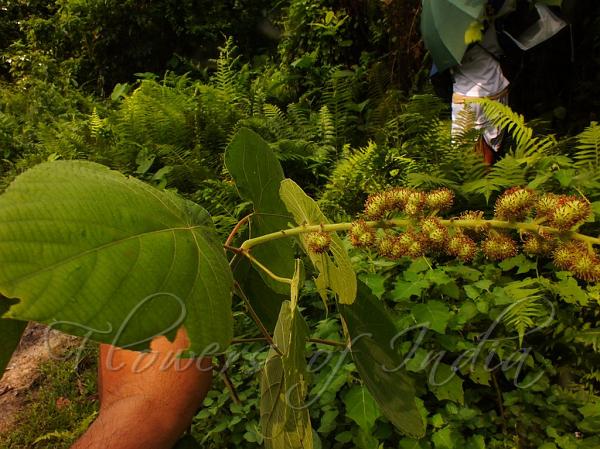|
| Shield-Leaf Kamala |
|

|

| File size | 275361 |
| Original date | 6/22/17 8:57 AM |
| Resolution | 1024 x 768 |
| Flash | Flash did not fire, auto |
| Focal length | 5.6mm |
| Exposure time | 1/59s |
| Aperture | 8.0 |
| Focus Distance | 0.0m |
| Metering Mode | Spot |
| Camera make | FUJIFILM |
| Camera model | FinePix HS35EXR |
| Sensor type | OneChipColorArea |
|
|
|
|
Photo: |
Botanical name: Mallotus roxburghianus Family: Euphorbiaceae (Castor family)
Synonyms: Rottlera peltata
Synonyms: Rottlera peltata
Shield-Leaf Kamala is a shrub or tree about 4-13 m
tall. Branchlets are yellow star-shaped-velvet-hairy and hairy.
Stipules are linear, 5-7 mm; leaf-stalk 5-10 cm; leaf blade
round-ovate, 8-20 × 7-18 cm, papery, above hairy, below
star-shaped-hairy and hairy along veins, glandular-scaly, base rotund,
broadly peltate, with 2-4 basal glands, margin repand-finely toothed,
tip with a tail-tapering; basal veins 7-9. Male inflorescences at
branch-ends, unbranched, 4-12 cm, woolly; bracts linear, about 5 mm.
Male flowers 3-5-fascicled; sepals 4, oblong, about 2 mm, velvet-hairy;
stamens 25-35. Female inflorescences 10-15 cm, woolly. Female flowers:
calyx urn-shaped, 6-lobed, lanceshaped, about 3 mm, pbescent; ovary
densely hairy; style 3-4 mm, base fused, plumose. Capsule are
3-locular, about 1.2 cm in diameter, hairy and shortly softly spiny;
flower-stalk 5-7 mm. Seeds are nearly spherical, about 4.5 mm,
brownish. Shield-Leaf Kamala is found on mountain slopes and forests, at
altitudes of 800-1500 m, in NE India. The dried material smells of
fenugreek. Flowering: July-August.
Medicinal uses: Shield-Leaf Kamala has long
been used by Mizo tribal people for the treatment of diabetes.
Shield-Leaf Kamala has long
been used by Mizo tribal people for the treatment of diabetes.
Medicinal uses:
 Shield-Leaf Kamala has long
been used by Mizo tribal people for the treatment of diabetes.
Shield-Leaf Kamala has long
been used by Mizo tribal people for the treatment of diabetes. | Identification credit: Tapas Chakrabarty | Photographed in Vishwanath Chariali, Assam. |
• Is this flower misidentified? If yes,